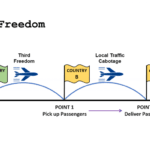Intermodal transport - advantages and disadvantages in logistics
Intermodal transport is a complex system of cargo transportation that uses different modes of transport using a single cargo unit (such as a container) without handling the goods themselves. This type of transport combines the advantages of road, rail and sea transport.
Check out our transportation services
What is intermodal transportation?
Intermodal transport allows to carry goods using different modes of transport, where a semi-trailer, container or swap body is moved between modes of transport at transshipment terminals. Throughout the route, the goods remain in the same cargo unit.
Types of transport modes in intermodal transport
Intermodal transportation uses:
- Rail transport (railcars adapted for the transport of containers)
- Road transport (truck tractor with semi-trailer sub-container)
- Maritime transport (container ships)

Advantages of intermodal transport
Intermodal transportation offers numerous benefits:
Environmental efficiency
- Reduction of greenhouse gas emissions
- Reducing the carbon footprint
- Optimize the use of infrastructure
Economic benefits
- Lower transportation costs on longer routes
- Ability to carry larger loads
- Efficient use of resources
Disadvantages of intermodal transport
The main challenges are:
- The need to develop transhipment infrastructure
- Higher initial costs
- Longer transport time on short routes
Transshipment terminals
A key element is intermodal terminals, where it occurs:
- Container handling
- Change of mode of transport
- Storage of cargo units
- Documentation handling
Intermodal versus multimodal transport - key differences
Main features of multimodal transport
- One operator responsible for all transportation
- Ability to change the loading unit
- One shipping document
Specifics of intermodal transport
- Fixed loading unit (container, trailer)
- Possibility to change the carrier
- Supply chain optimization
How does transshipment work in intermodal transportation?
Stages of cargo handling
- Preparation of the cargo unit for transshipment
- Use of specialized equipment
- Change of mode of transport
- Cargo security
Importance of transshipment terminals
Transshipment terminals provide:
- Infrastructure for efficient transshipment
- Container storage locations
- Documentation service
- Controlling the quality of handling
Intermodal transport in international logistics
Role in the supply chain
- Optimization of logistics processes
- Reduction of transportation costs
- Enhance cargo security
- Traceability
Intermodal transport in Poland
Poland is developing a network of transshipment terminals and rail infrastructure. The main intermodal transport hubs are located in:
- Seaports
- Logistics centers
- Points of contact of major transport routes
External sources:
FAQ - Frequently Asked Questions
What is the difference between intermodal and multimodal transportation?
Intermodal transport uses a single cargo unit for the entire route, while in multimodal transport, cargo can be trans-shipped between different units.
What are the main advantages of intermodal transportation?
- Reduction of CO2 emissions
- Cost optimization
- Greater cargo security
- Possibility of long-distance transportation
How does intermodal transportation work?
The goods are loaded into a container, which is then transported by various modes of transportation (e.g. truck -> train -> ship) without disturbing the contents.
The future of intermodal transport
The development of intermodal transportation is related to:
- Digitalization of logistics processes
- Automation of transshipment
- Infrastructure development
- New monitoring technologies
Intermodal transportation is becoming an increasingly important part of modern logistics, offering sustainable and efficient transportation solutions.
-
Q: What is intermodal transportation - definition?
A: Intermodal transport is the carriage of cargo using at least two different modes of transport, where the cargo is carried in a single cargo unit, such as a container, without the need for transshipment goods between different modes of transport.
Q: What are the advantages and disadvantages of intermodal transportation?
A: Advantages of intermodal transportation include cost efficiency, the ability to carry large loads and reduced environmental impact. Disadvantages include organizational complexity and dependence on the infrastructure of various modes of transportation.
Q: What are the types of intermodal transportation?
A: Types of intermodal transportation include road, rail and sea, among others. Each of these modes of transportation can be used in a single intermodal shipment, increasing flexibility in the delivery of goods.
Q: What is the importance of the container in intermodal transportation?
A: The container plays a key role in intermodal transportation, as it enables easy loading and unloading of cargo. With the use of containers, it is possible to transport goods without handling them, which increases the efficiency of the entire transportation process.
Q: How is intermodal transportation different from multimodal transportation?
A: Intermodal transport involves the use of different modes of transportation in a single shipment, but using a single cargo unit. Multimodal transport, on the other hand, can use different cargo units and modes of transportation, which makes it more flexible, but also more complicated.
Q: What are some examples of intermodal transportation?
A: Examples Intermodal transport includes the carriage of goods containerized cargo by sea, and then transport it to its destination by truck or train. Another example would be the transfer of containerized cargo onto rail cars and then transported by road to the customer.
Q: What factors affect the efficiency of intermodal transportation?
A: The efficiency of intermodal transport depends on many factors, such as the quality of transport infrastructure, the availability of carriers and the ability to synchronize different modes of transport. Application of modern technologies can also significantly improve the efficiency of the.
Q: What are the main challenges in organizing intermodal transportation?
A: The main challenges in organizing intermodal transportation include managing handling times, the need for coordination between different carriers, and complying with regulations in different countries. In addition, infrastructure issues can affect on-time delivery.
Q: What are the environmental benefits associated with intermodal transportation?
A: Intermodal transportation contributes to reducing CO2 emissions by optimizing routes and using greener modes of transportation, such as trains. As a result, this transportation has a lower environmental impact compared to traditional road transportation.





